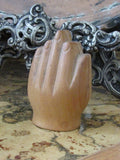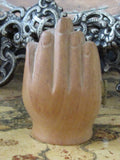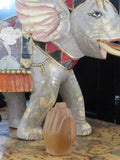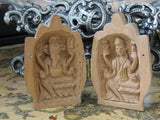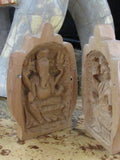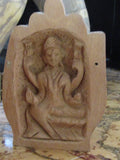Vintage Wooden Namaste Hindu Goddess Lakshmi Lord Ganesha Praying Hand Ethnic Wood Statuary Spiritual Religious Home Decor Alter Wealth
TheFlyingHostess
Regular price $22.75
Hand carved Hindu Goddess Lakshmi and Lord Ganesha praying namaste hand statuary made of lovely exotic wood. The two deities are worshiped together to balance wealth and wisdom. Lord Ganesha is the Hindu remover of obstacles, and his seated image is said to bring good luck especially to the home environment. This statue of Lord Ganesha makes a great wedding or prosperity gift. Measures 3 in tall, and 4 in across when opened
https://www.thoughtco.com/lakshmi-goddess-of-wealth-and-beauty-1770369
For Hindus, the goddess Lakshmi symbolizes good luck. The word Lakshmi is derived from the Sanskrit word Laksya, meaning "aim" or "goal," and in the Hindu faith, she is the goddess of wealth and prosperity of all forms, both material and spiritual.
For most Hindu families, Lakshmi is the household goddess, and she is a particular favorite of women. Although she is worshiped daily, the festive month of October is Lakshmi's special month. Lakshmi Puja is celebrated on the full moon night of Kojagari Purnima, the harvest festival that marks the end of the monsoon season.
Lakshmi is usually depicted as a beautiful woman of golden complexion, with four hands, sitting or standing on a full-bloomed lotus and holding a lotus bud, which stands for beauty, purity, and fertility. Her four hands represent the four ends of human life: dharma or righteousness, kama or desires, artha or wealth, and moksha or liberation from the cycle of birth and death.
Cascades of gold coins are often seen flowing from her hands, suggesting that those who worship her will gain wealth. She always wears gold embroidered red clothes. Red symbolizes activity, and the golden lining indicates prosperity. Said to be the daughter of the mother goddess Durga and the wife of Vishnu, Lakshmi symbolizes the active energy of Vishnu. Lakshmi and Vishnu often appear together as Lakshmi-Narayan—Lakshmi accompanying Vishnu.
Two elephants are often shown standing next to the goddess and spraying water. This denotes that ceaseless effort when practiced in accordance with one's dharma and governed by wisdom and purity, leads to both material and spiritual prosperity.
To symbolize her many attributes, Lakshmi may appear in any of eight different forms, representing everything from knowledge to food grains.
As a Mother Goddess
Worship of a mother goddess has been a part of Indian tradition since its earliest times. Lakshmi is one of the traditional Hindu mother goddesses, and she is often addressed as "mata" (mother) instead of just "devi" (goddess). As a female counterpart of Lord Vishnu, Mata Lakshmi is also called "Shr," the female energy of the Supreme Being. She is the goddess of prosperity, wealth, purity, generosity, and the embodiment of beauty, grace, and charm. She is the subject of a variety of hymns recited by Hindus.
As a Domestic Deity
The importance attached to the presence of Lakshmi in every household makes her an essentially domestic deity. Householders worship Lakshmi as a symbol of providing for the well-being and prosperity of the family. Fridays are traditionally the day on which Lakshmi is worshipped. Businessmen and businesswomen also celebrate her as a symbol of prosperity and offer her daily prayers.
Annual Worship of Lakshmi
On the full moon night following Dusshera or Durga Puja, Hindus worship Lakshmi ceremonially at home, pray for her blessings, and invite neighbors to attend the puja. It is believed that on this full moon night the goddess herself visits the homes and replenishes the inhabitants with wealth. A special worship is also offered to Lakshmi on the auspicious Diwali night, the festival of lights.
http://koausa.org/Gods/God8.html
Lord Ganesha - the Hindu deity in a human form but with the head of an elephant - represents the power of the Supreme Being that removes obstacles and ensures success in human endeavors. For this reason, Hindus worship Ganesha first before beginning any religious, spiritual or worldly activity. In Hindu mythology, Lord Ganesha is the first son of Lord Shiva and the Divine Mother Parvati. Their second son is Lord Subramanya and their daughter is Jyoti. As explained below, the portrayal of Lord Ganesha as the blend of human and animal parts symbolizes the ideals of perfection as conceived by Hindu sages and illustrates some philosophical concepts of profound spiritual significance.
Elephant head, wide mouth, and large ears: the large head of an elephant symbolizes wisdom, understanding, and a discriminating intellect that one must possess to attain perfection in life. The wide mouth represents the natural human desire to enjoy life in the world. The large ears signify that a perfect person is the one who possesses a great capacity to listen to others and assimilate ideas.
The trunk and two tusks with the left tusk broken: there is no known human instrument that has an operating range as wide as that of an elephant's trunk. It can uproot a tree and yet lift a needle off the ground. Likewise, the human mind must be strong enough to face the ups and downs of the external world and yet delicate enough to explore the subtle realms of the inner world. The two tusks denote the two aspects of the human personality, wisdom and emotion. The right tusk represents wisdom and the left tusk represents emotion. The broken left tusk conveys the idea that one must conquer emotions with wisdom to attain perfection.
Elephant eyes: the elephant eyes are said to possess natural deceptiveness that allows them to perceive objects to be bigger than what they really are. Thus the elephant eyes symbolize the idea that even if an individual gets "bigger and bigger" in wealth and wisdom, he should perceive others to be bigger than himself; that is, surrender one's pride and attain humility.
The four arms and various objects in the four hands: the four arms indicate that the Lord is omnipresent and omnipotent. The left side of the body symbolizes emotion and the right side symbolizes reason. An axe in the upper left hand and a lotus in the upper right hand signify that in order to attain spiritual perfection, one should cut worldly attachments and conquer emotions. This enables one to live in the world without being affected by earthly temptations, just as a lotus remains in water but is not affected by it. A tray of Laddus (a popular snack) near the Lord denotes that He bestows wealth and prosperity upon His devotees. The lower right hand is shown in a blessing pose, which signifies that Ganesha always blesses His devotees.
A human body with a big belly: the human body possesses a human heart, which is a symbol of kindness and compassion toward all. Ganesha's body is usually portrayed wearing red and yellow clothes. Yellow symbolizes purity, peace and truthfulness. Red symbolizes the activity in the world. These are the qualities of a perfect person who perforrns all duties in the world, with purity, peace, and truthfulness. The big belly signifies that a perfect individual must have a large capacity to face all pleasant and unpleasant experiences of the world.
A mouse sitting near the feet of Ganesha and gazing at the tray of Laddus: a mouse symbalizes the ego that can nibble all that is good and noble in a person. A mouse sitting near the feet of Ganesha indicates that a perfect person is one who has conquered his (or her) ego. A mouse gazing at the Laddus, but not consuming them, denotes that a purified or controlled ego can live in the world without being affected by the worldly temptations. The mouse is also the vehicle of Ganesha, signifying that one must control ego in order for wisdom to shine forth.
Right foot dangling over the left foot: as stated above, the left side of the body symbolizes emotion and the right side symbolizes reason and knowledge. The right foot dangling over the left foot illustrates that in order to live a successful life one should utilize knowledge and reason to overcome emotions.









